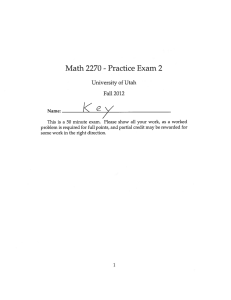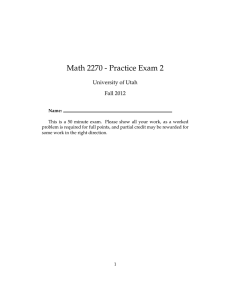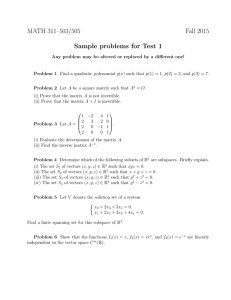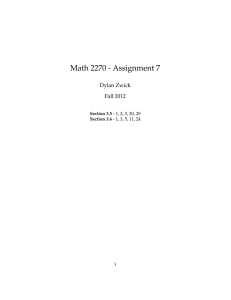Coheren t States of
advertisement
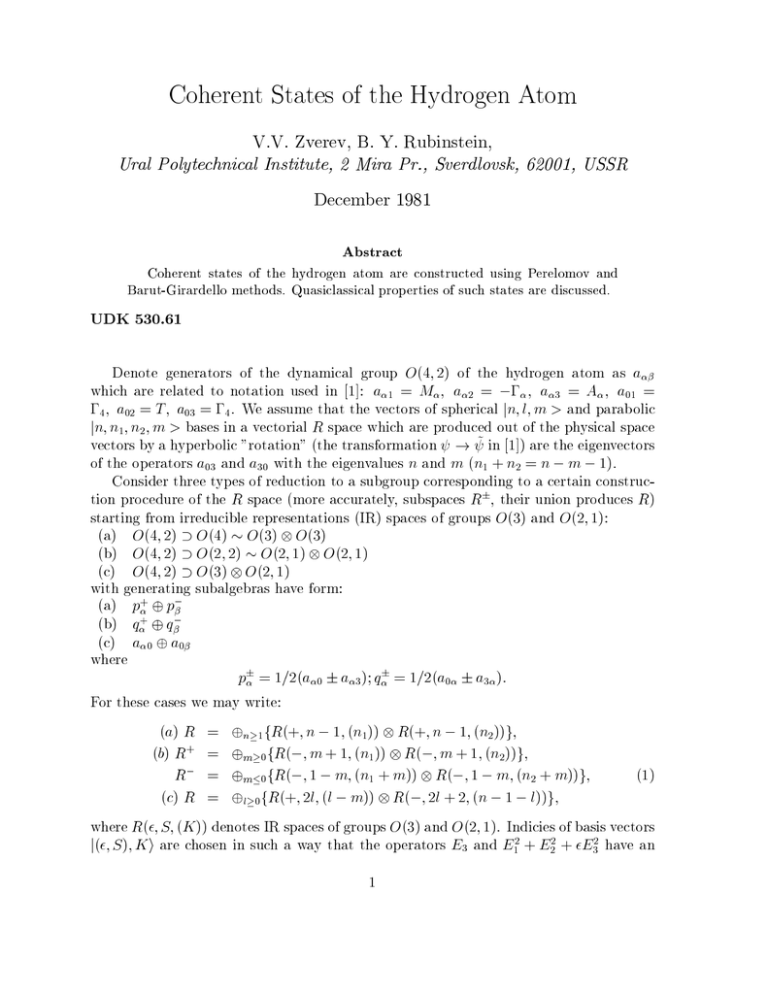
Coherent States of the Hydrogen Atom
V.V. Zverev, B. Y. Rubinstein,
Ural Polytechnical Institute, 2 Mira Pr., Sverdlovsk, 62001, USSR
December 1981
Abstract
Coherent states of the hydrogen atom are constructed using Perelomov and
Barut-Girardello methods. Quasiclassical properties of such states are discussed.
UDK 530.61
Denote generators of the dynamical group O(4; 2) of the hydrogen atom as a
which are related to notation used in [1]: a1 = M ; a2 =
; a3 = A ; a01 =
4 ; a02 = T; a03 = 4 . We assume that the vectors of spherical jn; l; m > and parabolic
jn; n1; n2 ; m > bases in a vectorial R space which are produced out of the physical space
vectors by a hyperbolic "rotation" (the transformation ! ~ in [1]) are the eigenvectors
of the operators a03 and a30 with the eigenvalues n and m (n1 + n2 = n m 1).
Consider three types of reduction to a subgroup corresponding to a certain construction procedure of the R space (more accurately, subspaces R , their union produces R)
starting from irreducible representations (IR) spaces of groups O(3) and O(2; 1):
(a) O(4; 2) O(4) O(3) O(3)
(b) O(4; 2) O(2; 2) O(2; 1) O(2; 1)
(c) O(4; 2) O(3) O(2; 1)
with generating subalgebras have form:
(a) p+ p
(b) q+ q
(c) a0 a0
where
p = 1=2(a0 a3 ); q = 1=2(a0 a3 ):
For these cases we may write:
(a) R
(b) R+
R
(c) R
=
=
=
=
n1fR(+; n 1; (n1)) R(+; n 1; (n2))g;
m0 fR( ; m + 1; (n1)) R( ; m + 1; (n2))g;
m0 fR( ; 1 m; (n1 + m)) R( ; 1 m; (n2 + m))g;
l0fR(+; 2l; (l m)) R( ; 2l + 2; (n 1 l))g;
(1)
where R(; S; (K )) denotes IR spaces of groups O(3) and O(2; 1). Indicies of basis vectors
j(; S ); K i are chosen in such a way that the operators E3 and E12 + E22 + E32 have an
1
eigenvalues S=2 K and S=2 + S 2 =4 correspondingly. Here E are generators of these
groups; = 1 (or ); plus(minus) signs correspond to group O(3) (O(2; 1)); s = 1; 2; : : :
denotes IR; k = 0; 1; : : : and not exceeds s for O(3) and is unlimited for O(2; 1).
The vectorial subspaces with maximal jn; 0; 0; n 1i (minimal
jn; n 1; n 1; n + 1i) values of magnetic quantum number correspond to the circular
orbits (CO) [2] which are the main vectors in the subspaces generating the diadic sums
(2). The IR of group O(2; 1) for s = 1 enters the subspaces of CO vectors: corresponding
generators are
1
1
1
1 = (a11 a22 ); 2 = (a21 a12 ); 3 = (a03 a30 );
2
2
2
where corresponds to the vectorial subspace with m = (n 1).
Using the methods discussed in [3] we construct coherent states (CS) in the subspace
R in two stages { at the rst one we introduce CS in the CO vectorial subspaces (using
the operators ), and then we construct CS in R using the generators of subgroups in
(2). Consider the CS of groups O(3) and O(2; 1) using the generating operators (we omit
explicit expressions given in [4, 5]:
j(; S ); !i = D ((; S ); !; (K))j(; S ); K = 0i;
(2)
where = 1 corresponds to CS introduced by Perelomov in [4] for O(3) and O(2; 1);
= 2 corresponds to CS by Barut and Girardello in [5] for O(2; 1). We call the CS j i i
quasiclassical if they have a classical limit (CL) property jh i j k ij2 ! 0 for j i i 6= j k i
(h i j i i = 1), and if the mean values of the operator products tend to the product of
mean values. Perelomov's CS are quasiclassical at s ! 1, and Barut-Girardello CS have
this property at xed s and j! j ! 1. It should be underlined that there are dierent
limiting operations to CL transformation for dierent types of CS.
The value of s is xed for O(2; 1) IR in the CO vector spaces, hence at the rst stage
we use the Barut-Girardello method to produce the quasiclassical states arriving at:
j!i = D2(( ; 1); !; ( ))j1; 0; 0; 0i:
(3)
At j! j ! 1 main contribution to mean values calculated with the states (3) comes out
of CO vectors with large n. For each O(3) and O(2; 1) IR space this number plays a role
of the index s, so at the second stage we use the Perelomov method. Then each reduction
scheme in (2) corresponds to a separate construction method of hydrogen atom CS:
jO(4); !; ; i
jO(2; 2); !; ; i
jO(3) O(2; 1); !; ; i
= D1 ((+); ; (p+ ))D1 ((+); ; (p ))j! i;
= D1 (( ); ; (q+ ))D1 (( ); ; (q ))j! i;
= D1 ((+); ; (a0 ))D1 (( ); ; (a0 ))j! i:
(4)
(5)
(6)
Consider a transition to CL for the CS of the type (4) with plus sign chosen. Consider
the CS in the equivalent form using another parametrization
T (; ; ) exp(ia13 )j! i;
and nd mean values in these CS. The rotation operator T (; ; ), determining an
angular position of an electron density in a physical space, may be omitted. Considering
2
the mean values of the main quantum number, angular moment components, electron
position vector components and its modulus calculated using the CS exp(ia13 )j! i one
may deduce that in the limit j! j ! 1 these CS describe a wave packet moving along an
elliptic orbit with an eccentricity sin (the angular moment is equal to hni cos ; hni j!j). The angular position of the packet center is determined by the parameter arg !.
Averaging Heisenberg equation for electron position using the CS and replacing averages
of products by products of averages (this operation is valid in quasiclassical limit) one
can produce classical Kepler equation of motion.
In conclusion, the suggested method of CS construction for hydrogen atom diers
from that of described in [3], in which at both construction stages the Perelomov method
was used. CS discussed there are not quasiclassical contrary to CS introduced in this
communication.
References
[1] A.Barut, R.Ronchka, Theory of Group Representations with Applications, vol. 2,
Mir Publishers, 1980.
[2] L.S.Brown, Am.Journ.Phys.,41,525 (1973).
[3] J.Mostowsky, Lett.Math.Phys.,2,1 (1977).
[4] A.M.Perelomov, UFN,123,23 (1977).
[5] A.O.Barut, L.Girardello, Comm.Math.Phys.,21,41 (1971).
Published in Kratkie Soobshcheniya po zike FIAN im. Lebedeva, 11, 1, 1982.
Translated from Russian by BYR.
3

